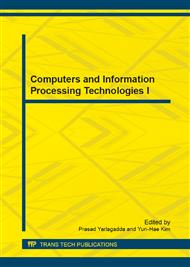[1]
S. Li, W.K. Liu. Meshfree and particle methods and their applications. Applied Mechanics Re- views. 55(1) (2002), pp.1-34.
Google Scholar
[2]
T. Belytschko, Y. Krongauz, D. Organ, et. al. Meshless methods: an overview and recent develop- ments. Computer Methods in Applied Mechanics and Engineering. 139(1996), pp.3-47.
DOI: 10.1016/s0045-7825(96)01078-x
Google Scholar
[3]
P.F. Thomas, H.G. Matthies. Classification and overview of meshfree methods. Germany Bruns- wich Informatikbericht (2003).
Google Scholar
[4]
S. Koshizuka , Y. Oka. Moving-Paricle Semi-Implicit Method for Fragmentation of Incompressi- ble Fluid. 123 (1996), pp.421-434.
DOI: 10.13182/nse96-a24205
Google Scholar
[5]
A. Sjalonaeomoa, Y.C. Jin. MPS mesh-free particle method for multiphase flows. Comput. Me- thods Appl. Mech. Engrg. 229-232(2012), pp.13-16.
Google Scholar
[6]
S. Park, G. Jeun. Coupling of rigid body dynamics and moving particle semi-implicit method for simulation isothermal multi-phase fluid interactions. 200(2011), pp.130-140.
DOI: 10.1016/j.cma.2010.08.001
Google Scholar
[7]
W.X. Tian, Y. Ishiwatari, et. al. Numerical simulation on void bubble dynamics using moving par- ticle semi-implicit method. 239(2009), pp.2382-2390.
DOI: 10.1016/j.nucengdes.2009.06.018
Google Scholar
[8]
Z.G. Sun, Y.Y. Liang and G. Xi. Numerical simulation of the flow in straight blade agitator with MPS method. Internatioal journal for numerical methods in fluids. 67(2011), p.1960-(1972).
DOI: 10.1002/fld.2474
Google Scholar
[9]
M. Sueyoshi, M. Kashiwagi and S. Naito. J Mar Sci Technol. Numerical simulation of wave-indu- ced nonlinear motions of a two-dimensional floating body bu the moving particle semi-implicit method. J Mar Sci Technol, 13(2008), pp.85-94.
DOI: 10.1007/s00773-007-0260-y
Google Scholar
[10]
S.D. Shao, Y.M. Lo. Incompressible SPH method for simulating Newtonian and non-Newtonian flows with a free surface. Advances in Water Resources, 26(7)(2003), pp.787-800.
DOI: 10.1016/s0309-1708(03)00030-7
Google Scholar
[11]
S. Cummins, R. Murray. An SPH projection method. J. Coumut. Phys, 152(2) (1999), pp.584-607.
Google Scholar
[12]
J.J. MONAGHAN. Simulation free surface flow with SPH Journal of Computational Physics. 110 (1994), pp.399-406.
Google Scholar
[13]
C.G. Koh, M. Gao and C. Luo. A new particle method for simulation of incompressible free sur- face flow problems. International journal for numerical methods in engineering, 89(2012), pp.1582-1604.
DOI: 10.1002/nme.3303
Google Scholar


